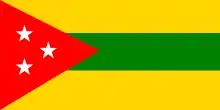 | |
| Use | National flag and ensign |
|---|---|
| Proportion | 2:3 |
| Adopted | May 22, 1990 |
| Design | A horizontal tricolour of red, white and black |
| Presidential standard | |
 | |
| Proportion | 2:3 |
| Design | The national flag with the Yemeni coat of arms on the canton corner. |
| flag of the Armed Forces | |
 | |
| Proportion | 2:3 |
| Design | The national flag with the Emblem of the Yemeni Armed Forces in the canton corner. |
| Army flag | |
 | |
| Proportion | 2:3 |
| Design | A red field with the national flag in the canton corner, and the Emblem of the Yemeni Armed Forces centered on the fly side. |
| Navy Flag | |
 | |
| Proportion | 2:3 |
| Design | A blue field with the national flag in the canton corner, and the Emblem of the Yemeni Navy centered on the fly side. |
| Air force flag | |
 | |
| Proportion | 2:3 |
| Design | A sky blue field with the national flag in the canton corner, and the Emblem of the Yemeni Air Force centered on the fly side. |
The State flag of Yemen (Arabic: علم اليمن, romanized: Alam al-Yaman) was adopted on May 22, 1990, the day that North Yemen and South Yemen were unified. The flag of Yemen is basically the Arab Liberation Flag of 1952, introduced after the Egyptian Revolution of 1952 in which Arab nationalism was a dominant theme. The Arab Liberation Flag of 1952 served as the inspiration for the flags of both North and South Yemen prior to unification, as well as for the current flags of Egypt, Iraq, Sudan, Palestine and Syria.[1]
According to the official description, the red stands for unity and the bloodshed of martyrs, the white for a bright future, and the black for the supposed dark past. The flag is graphically identical to the flag of the Libyan Arab Republic from 1969 to 1972.[1]
Colors
Construction sheet
.svg.png.webp)
Meaning behind the colors
| Scheme | Textile colour |
|---|---|
| Red | the blood of martyrs who struggle to achieve independence and unity[2][3] |
| White | Represents a bright future[2][3] |
| Black | To stand for the dark days of the past[2][3] |
Color shades
| Scheme | Red | White | Black |
|---|---|---|---|
| Hex triplet | #CE1126 | #FFFFFF | #000000 |
| RGB | 206–17–38 | 255–255–255 | 0–0–0 |
Government flags
 Flag of the Yemeni Interior Ministry.
Flag of the Yemeni Interior Ministry. Flag of the Yemeni Republican Guard
Flag of the Yemeni Republican Guard Flag of the Yemeni Special Security Forces
Flag of the Yemeni Special Security Forces
Regional Flags
The Federalization of Yemen or the Federal Republic of Yemen was the outcome of the National Dialogue Conference, the Dialogue members also agreed that Yemen would be transformed into a six-region federal system.[4] The regions would be Azal in the North, and Saba in the center, and Tihama in the West, and Aden and Jand in the South, and Hadramawt in the East.
 Flag of Aden Region
Flag of Aden Region Flag of Azal Region.
Flag of Azal Region. Flag of Hadhramaut Region.
Flag of Hadhramaut Region..svg.png.webp) Flag of Janad Region.
Flag of Janad Region..svg.png.webp) Flag of Saba Region.
Flag of Saba Region..svg.png.webp) Flag of Tahama Region.
Flag of Tahama Region.
Historical flags
Before Yemen was unified into the present-day Republic of Yemen in 1990, it existed as two states, North and South Yemen.
North Yemen
 | |
| Use | Historical |
|---|---|
| Proportion | 2:3 |
| Adopted | November 1, 1962 (slight adaptation from September 26, 1962) |
| Relinquished | May 22, 1990 (Yemeni unification) |
| Design | A horizontal tricolour of red, white and black with a green five-pointed star in the centre |
After its independence from the Ottoman Empire, the Mutawakkilite Kingdom of Yemen used a red flag with a sword and stars for most of its existence, from 1927 to 1962. When it became the Yemen Arab Republic in 1962, the flag adopted the Arab Liberation colors of 1952 with one green star in the center of the white band.
 Kingdom of Yemen
Kingdom of Yemen
(1918–1923).svg.png.webp) Kingdom of Yemen
Kingdom of Yemen
(1923–1927)
 Yemen Arab Republic
Yemen Arab Republic
(1962–1990)
South Yemen
 | |
| Use | Historical |
|---|---|
| Proportion | 2:3 |
| Adopted | November 30, 1967 |
| Relinquished | May 22, 1990 (Yemeni unification) |
| Design | A horizontal tricolour of red, white and black with a sky-blue chevron with a tilted red star (the emblem of the Yemeni Socialist Party) next to the hoist. |
The flag of the People's Democratic Republic of Yemen in the South was the Arab Liberation Flag of 1952 with a sky-blue chevron with a red star (the emblem of the Yemeni Socialist Party) next to the hoist. The flag was adopted on 30 November 1967 when South Yemen declared independence from the United Kingdom until the Yemeni unification in 1990. It was used again for a few months in 1994 during the existence of the Democratic Republic of Yemen. Today, the South Yemeni flag is used by the separatist supporters from the Southern Movement and the Southern Transitional Council.
 People's Democratic Republic of Yemen (1967–1990)
People's Democratic Republic of Yemen (1967–1990) People's Democratic Republic of Yemen (1967–1990), Presidential Standard
People's Democratic Republic of Yemen (1967–1990), Presidential Standard
 Flag of South Yemen, vertical standard
Flag of South Yemen, vertical standard
Federation of South Arabia
.svg.png.webp) Colony of Aden (1937–1963)
Colony of Aden (1937–1963) Federation of South Arabia (1962–1967)
Federation of South Arabia (1962–1967) State of Aden (1963–1967)
State of Aden (1963–1967)







Other Yemeni polities
Eastern Yemen
The Protectorate of South Arabia consists of states located at the southern central tip of the Arabian Peninsula (Hadhramaut) under protection agreements with Britain. The states did not join the Federation of South Arabia. The protectorate became from southern Yemen after the Radfan uprising and the coup against the Sultans of the provinces. Now it is part of the Republic of Yemen.
Protectorate of South Arabia

.svg.png.webp) Qu'aiti (1880-1939)
Qu'aiti (1880-1939) Qu'aiti (1939-1967)
Qu'aiti (1939-1967)

 Upper Yafa, located outside the borders of Hadhramaut
Upper Yafa, located outside the borders of Hadhramaut
Political flags


 Ba'ath Party Flag
Ba'ath Party Flag Ansarullah Flag
Ansarullah Flag
See also
References
- 1 2 Smith, Whitney (February 16, 2001). "Flag of Yemen". Britannica. Retrieved June 12, 2018.
- 1 2 3 "Flag of Yemen | History, Design & Meaning | Britannica". www.britannica.com. Retrieved 2023-10-24.
- 1 2 3 Crouch, Alex (2015-05-18). "Flag of Yemen". The Flag Institute. Retrieved 2023-10-24.
- ↑ "Yemen to become six-region federation". Al Jazeera English. 10 Feb 2014. Retrieved 16 March 2014.

